|
|
|
The Birds Of North And Middle America: A Descriptive Catalogue
Part X: Family Cracidae - The Curassows, Guans, and Chachalacas, Family Tetraonidae - The Grouse, Ptarmigan, etc., Family Phasianidae - The American Quails, Partridges, and Pheasants, Family Numididae - The Guineafowls, Family Meleagrididae - The Turkeys
Robert Ridgway continued by Herbert Friedmann
Bulletin No. 50
Smithsonian Institution
United States National Museum
1946
From the preface: "In the ten volumes thus far published there have been treated in detail (that is, with full descriptions and synonymies), besides the families above mentioned and higher groups to which they belong, 695 genera and 2,756 species and subspecies, besides 237 extralimital genera and 638 extralimital species and subspecies whose principal characters are given in the keys and whose principal synonymy is given in footnotes. ...... As in Part IX, the author has made extensive use of the manuscript notes left by the late Robert Ridgway. His notes covered the diagnoses of genera and higher groups and partial synonymies for many of the species and subspecies. Wherever possible his manuscript has been included with the minimum of change (other than addition to synonymies) permitted by more recent data. In fact, it has been, and still is, the present author's feeling that this work should be as largely Ridgway's as possible; thus, for instance, he has kept and included Ridgway's diagnoses of certain genera now relegated to the position of subgenera, and where Ridgway's manuscript gave extensive synonymies for extralimital forms, he has retained them without attempting to supply equally detailed accounts for other extralimital forms. However, all such manuscript material has been thoroughly studied with the specimens and the literature; nothing has been accepted merely because it was written. From the start, the author has felt himself responsible for the entire contents of this volume and has not considered himself as an editor of an unpublished work."
|
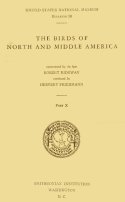
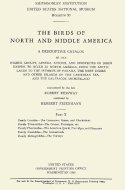
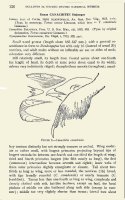 |
|
The Birds Of North And Middle America: A Descriptive Catalogue
Part IX: Family Gruidae - The Cranes, Family Rallidae - The Rails, Coots, and Gallinules, Family Heliornithidae - The Sun-grebes, Family Eurypygidae - The Sun-bitterns
Robert Ridgway continued by Herbert Friedmann
Bulletin No. 50
Smithsonian Institution
United States National Museum
1941
From the preface: "In the nine volumes thus far published there have been treated in detail (that is, with full descriptions and synonymies), besides the families above mentioned and higher groups to which they belong, 667 genera and 2,578 species and subspecies, besides 220 extralimital genera and 626 extralimital species and subspecies whose principal characters are given in the keys and whose principal synonymy is given in footnotes. ....... The author takes this opportunity to explain the status of his own position in this work. On the death of Robert Ridgway, the late Dr. Charles W. Richmond gathered together all the former's manuscripts he could find and carefully filed them for future use. Ridgway's notes covered the diagnoses of genera and higher groups and partial synonymies for many of the species and subspecies. Whenever possible, his manuscript has been included with the minimum of change (other than addition to synonymies) permitted by more recent data. In fact, it has been the present author's feeling that this work should be as largely Ridgway's as possible; thus, for instance he has kept and included Ridgway's diagnoses of certain genera now relegated to the position of subgenera, and where Ridgway's manuscript gave
extensive synonymies for extralimital forms, he has retained them without attempting to supply equally detailed accounts for other extralimital forms. However, all such manuscript material has been thoroughly studied with the specimens and the literature; nothing has been accepted merely because it was written. From the start, the author has felt himself responsible for the entire contents of this volume and has not considered himself as an editor of an unpublished work."
|
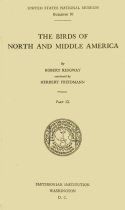
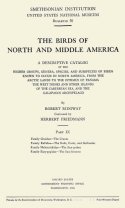
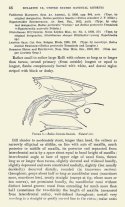 |
|
The Birds Of North And Middle America: A Descriptive Catalogue
Part VIII: Family Jaoanidae - The Jacanas, Family Cadiciiemidae - The Thick-knees, Family Haematopodidae - The Oyster-oatohers, Family Arenariidae - The Turnstones, Family Aphrizidae - The Surf Birds, Family Oharadriidae - The Plovers, Family Scolopacidae - The Snipes, Family Phalaropodidae - The Phalaropes, Family Recurvirostridae - The Avocets and Stilts, Family Rynohopidae - The Skimmers, Family Sternidae - The Terns, Family Laridse - The Gulls, Family Stercorariidae - The Skuas, Family Alcidae - The Auks
Robert Ridgway
Bulletin No. 50
Smithsonian Institution
United States National Museum
1919
From the preface: "In the eight volumes thus far published have been treated in detail (that is, with full descriptions and synonymies), besides the Families above mentioned and higher groups to which they belong, 651 genera and 2,507 species and subspecies, besides 213 extralimital genera and 602 extralimital species and subspecies whose principal characters are given in the Keys and their principal synomyny full synomymy in case of the genera) given in footnotes. Certain subspecies (mostly among the Limicolae) recognized by other authors have not been admitted in the present work. This
does not necessarily mean that they are not worthy of recognition, but that the material examined (usually wholly inadequate for determination of the question) did not warrant subdivision of the species. ....... Measurements of specimens for use in the preparation of the present volume were made by Mr. Riley and Miss Celestine B. Hodges, and the orignal drawings of the outline figures illustrating the generic characters (fig. I-XXXIV), except those previously published, were made by Mr. E. R. Kalmbach, of Washington. It may be added that printing of the present volume has been greatly retarded by exigencies resulting from prosecution of the World War, now happily ended."
|
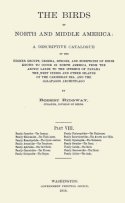
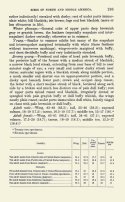
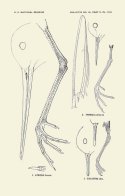 |
|
The Birds Of North And Middle America: A Descriptive Catalogue
Part VII: Family Cuculidae, Family Psittacidae, Family Columbidae
Robert Ridgway
Bulletin No. 50
Smithsonian Institution
United States National Museum
1916
From the preface: "The seven volumes thus far published are treated in detail (that is, with full descriptions and synonymies), besides the Families above mentioned and the higher groups to which they belong, 564 genera and 2,319 species and subspecies, besides 191 extralimital genera and 561 extralimital species and subspecies whose diagnostic characters are given in the 'Keys' and their principal synonymy (full synonymy in case of the genera) given in footnotes. Acknowledgments are due to the same individuals and institutions as those mentioned in previous volumes for the loan of specimens needed in the preparation of the present one; also to the State University of Iowa (through Prof. C. C. Nutting) for the privilege of examining a series of 16 specimens of the Louisiana Parroquet from the Indian Territory. To Dr. Charles W. Richmond, Acting Curator of the Division of Birds, U. S. National Museum, the author is indebted for the privilege of free access to his unique and extremely valuable card-catalogue collection of references to the first publication of generic, specific, and subspecifio names, for information concerning puzzling questions of nomenclature, and invaluable help in reading proof sheets; and to Mr. J. H. Riley, Aid in the Division of Birds, for assistance in various ways. Measurements of specimens for use in the preparation of the present volume were made by Miss Celestine B. Hodges, and the original drawings of the outline figures illustrating generic details (Fig. I-XXIV), except those previously published, were made by Miss Helen E. Lewis, both of Washington, D. C."
|
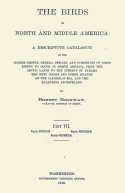
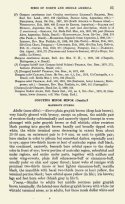
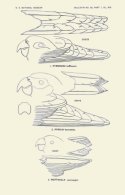 |
|
The Birds Of North And Middle America: A Descriptive Catalogue
Part VI: Family Picidae - The Woodpeckers, Family Oapitonidae - The Baaets, Family Ramphastidae - The Toucans, Family Buooonidae - The Puff Birds, Family Galbdlidae - The Jacamars, Family Aloedinidae - The Kingfishers, Family Todidae - The Todies, Family Momotidae - The Motmots, Family Oapkimulgidae - The Goatsuckers, Family Ntctibidae - The Potoos, Family Tttonibae - The Barn Owls, Family Bubonidae - The Eared Owls
Robert Ridgway
Bulletin No. 50
Smithsonian Institution
United States National Museum
1914
From the preface: "More than one-third of the present volume (pp. 1-309, inclusive) was printed in 1911, having been intended for Part V; but, as stated in the Preface to that volume, could not be included therein without unduly increasing the bulk. The matter has, however, been revised, and to a large extent reset, in order to bring the subject up to date. A similar fate has befallen two large groups intended for the present volume, namely, the Coccygifonnes (Cuckoo-like Birds) and Psittaciformes (Parrots); the former having been left out at the last moment (for the same reason as were the Woodpeckers from Part V), after having been entirely put in type, the latter in large part completed in manuscript. ……. In these six volumes are treated, in detail (that is, with full synonymies and descriptions), besides the Families above mentioned and the higher groups to which they, respectively, belong, 520 genera, 2111 species and subspecies, besides 155 extralimital genera and 478 extralimital species and subspecies whose diagnostic characters are given in the 'keys', and their principal synonymy (full synonymy in case of the genera) given via footnotes. ……. The original drawings of the outline figures illustrating generic details (Pis. I-XXXVI), except those previously published, were made by Miss Ruth G. Collette, of Washington, D. C.."
|
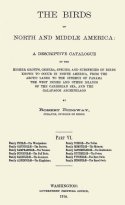

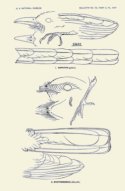 |
|
Color Standards And Color Nomenclature
Robert Ridgway
1912
From the preface: "The motive of this work is THE STANDARDIZATION OF COLORS AND COLOR NAMES. The terminology of Science, the Arts, and various Industries has been a most important factor in the development of their present high efficiency. Measurements, weights, mathematical and chemical formulae, and terms which clearly designate practically every variation of form and structure have long been standardized ; but the nomenclature of colors remains vague and, for practical purposes, meaningless, thereby seriously impeding progress in almost every branch of industry and research. Many works on the subject of color have been published, but most of them are purely technical, and pertain to the physics of color, the painter's needs, or to some particular art or industry alone, or in other ways are unsuited for the use of the zoologist, the botanist, the pathologist, or the mineralogist; and the comparatively few works on color intended specially for naturalists have all failed to meet the requirements, either because of an insufficient number of color samples, lack of names or other means of easy identification or designation, or faulty selection and classification of the colors chosen for illustration. More than twenty years ago the author of the present work attempted to supply the deficiency by the publication of a book* containing 186 samples of named colors, but the effort was successful only to the extent that it was an improvement on its predecessors; and, although still the standard of color nomenclature among zoologists and many other naturalists, it nevertheless is seriously defective in the altogether inadequate number of colors represented, and in their unscientific arrangement. Fully realizing his failure, the author, some two or three years later, began to devise plans, gather materials, and acquire special knowledge of the subject, in the hope that he might some day be able to prepare a new work which would fully meet the needs of all who have use for it. Unfortunately, his time has been so fully occupied with other matters that progress has necessarily been slow ; but after more than twenty years of sporadic effort it has at last been completed."
|
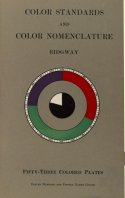
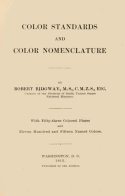
 |
|
The Birds Of North And Middle America: A Descriptive Catalogue
Part V: Family Pteroptochidae - The Tapaeuloa, Family Dendrocolaptidae - The Woodhewers, Family Formicariidae - The Antbirds, Family Trochilidae - The Humming Birds, Family Furnariidae - The Ovenbirds, Family Micropodidae-The Swifts, Family Trogonidae - The Trogons
Robert Ridgway
Bulletin No. 50
Smithsonian Institution
United States National Museum
1911
From the preface: "Circumstances have retarded the completion of the present volume, chief among which were interruption by field work (including a second visit to Costa Rica), occasional periods of illness, and the specially-
difficult character of some of the included groups; furthermore, one large family (the Woodpeckers, Picidae) was worked up and even set in type, but was finally omitted because its inclusion would increase the bulk of the volume far beyond a convenient size. It will, therefore, be included in Part VI. ……. The present volume contains the Tracheophone Mesomyodi, represented by the Families Pteroptochidae (Tapaculos), Formicariidae (Antbirds), Furnariidae (Ovenbirds), and Dendrocolaptidae (Woodhewers), together with the Macrochires, containing the Families Trochilidae (Humming Birds) and Micropodidae (Swifts), and the
Heterodactylae, represented only by the Family Trogonidae (Trogons). The number of species and subspecies described in the five volumes is 2,038, with 351 additional extralimital forms characterized in the 'keys.' About 1,150 to 1,200 forms remain to be treated in subsequent parts of the work. Acknowledgments for the loan of specimens for use in the preparation of the present volume are due to the same individuals and public institutions as have already been named in previous volumes; also to Mr. C. H. Lankester, of Cachi, Costa Rica, who kindly placed the Tracheophones of his fine collection of Costa Rican birds at the author's service."
|
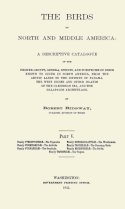

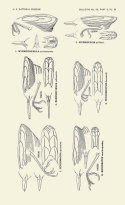 |
|
Birds Of The World: A Popular Account
Frank H. Knowlton
With A Chapter On The Anatomy Of Birds By Frederic A. Lucas
The Whole Edited By Robert Ridgway
Henry Holt & Company
1909
From the preface: "IT is perhaps hardly necessary to call attention to the great awakening of popular interest that has come about in recent years in relation to our birds, an interest that has been fostered not only by the admirable work of the Audubon Societies and the widespread nature teaching in the schools, but by the deeper, broader sentiment which is leading back to, and nearer to, Nature. The increasing number of people yearly turning back to the country, either for recreation or permanent residence, has naturally stimulated a desire to know more intimately their surroundings, the trees, the flowers, and the birds. Few of these people have either the inclination or the desire to become professional ornithologists, but they have wished to know at least the names and more interesting facts in the life histories of the birds they see constantly about them. To supply this demand for popular information, a large number of works have been written, and their extensive circulation proves that they have filled a real want. But most of these are more or less local in their scope, only a very few, for instance, treating of the birds of a whole country, and the time seems ripe for a work of moderate size, and in a single volume, that shall set forth in non-technical language the salient facts regarding the birds of the world. Such a work I have attempted to prepare ."
|


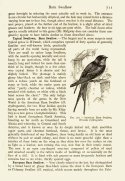 |
|
The Birds Of North And Middle America: A Descriptive Catalogue
Part IV: Family Turdidae - Thrushes, Family Mimidae - Mockingbirds, Family Alaudidae - Larks, Family Sturnidae - Starlings, Family Ploceidae - Weaver Birds, Family Oxyruncidae - Sharpbills, Family Tyrannidae - Tyrant Flycatchers, Family Pipridae - Manakins, Family Cotingidae - Chatterers
Robert Ridgway
Bulletin No. 50
Smithsonian Institution
United States National Museum
1907
From the preface: "The present volume comprises the Turdidae (Thrushes), Mimidae (Mockingbirds), Alaudidae (Larks), Family Sturnidae (Starlings), Family Ploceidae (Weaver Birds), Family Oxyruncidae (Sharpbills), Family Tyrannidae (Tyrant Flycatchers), Family Pipridae (Manakins), and Cotingidae (Chatterers). Part V, which is partly done, includes the Formicariidae (Ant Birds), Dendrocolaptidae (Wood-Hewers), Furnariidae (Oven Birds), Pteroptochidae (Taparolas), Trochilidffi (Humming Birds), Micropodidae (Swifts), Caprimulgidae (Goatsuckers), and Picidae (Woodpeckers). In the four volumes published there have been described 1,675
species and subspecies, or somewhat more than half the total number of North and Middle American Birds. Acknowledgments are due for the loan of specimens used in the preparation of this volume to those individuals and public institutions mentioned in preceding volumes; also to the Carnegie Museum, of Pittsburg, Pennsylvania (through Mr. W. E. Clyde Todd, in charge of the bird collection); the Museum of Comparative Zoology, Cambridge, Massachusetts (through Mr. William Brewster); Dr. Louis B. Bishop, of New Haven, Connecticut; Mr. J. II. Fleming, of Toronto, Canada, and Mr. Arthur T. Wayne, of Mount Pleasant, South Carolina. The specimens from the Carnegie Museum were especially helpful, consisting of fine series of beautifully prepared specimens, mostly from Costa Rica. ……. The illustrations in this volume not previously published were
mostly made by Mr. H. W. Hendley, of Washington, District of Columbia, and the measurements of specimens were made chiefly by Mr. J. H. Riley, of the Division of Birds."
|
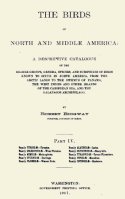
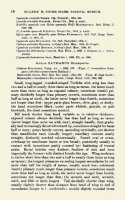
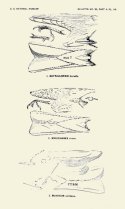 |
|
The North American Eagles And Their Economic Relations
Harry C. Oberholser
Two b/w plates: R. Ridgway
Biological Survey Bulletin No. 27
U.S. Department of Agriculture
Government Printing Office
1906
From the introduction: "The present purpose is to bring together such facts as have bearing on the economic relations of the North American eagles; and this bulletin has therefore to do with the distribution of the several species, their general manner of life, as well as, most important of all, their food habits. It is difficult to obtain stomachs of eagles for examination, hence few data of this kind have been available at first hand; but all other sources of information have been utilized in order that this report may represent as nearly as possible our present knowledge of the subject.
|
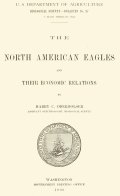
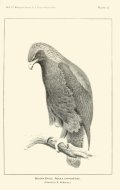 |
|
The Birds Of North And Middle America: A Descriptive Catalogue
Part III: Family Motacillidae - Wagtails and Pipits, Family Hirundinidae - Swallows, Family Ampelidae - Waxwings, Family Ptilogonatidee - Silky Flycatchers, Family Dulidee - Palm Chats, Family Vireonidae - Vireos, Family Laniidae - Shrikes, Family Corvidae - Crows and Jays, Family Paridae - Titmice, Family Sittidae - Nuthatches, Family Certhiidae - Creepers, Family Troglodytidae - Wrens, Family Cinclidae - Dippers, Family Chamacidae - Wren-Tits, Family Sylviidae - Warblers
Robert Ridgway
Bulletin No. 50
Smithsonian Institution
United States National Museum
1904
From the preface: "Although nearly five hundred pages of the present volume were printed during the year 1903, the author's inability to complete the manuscript in time necessitated suspension of presswork until July, 1904; hence publication of the volume has been delayed much beyond the anticipated date. ……. The present volume comprises the Motacillidae (Wagtails and Pipits), Hirundinidae (Swallows), Ampelidae (Waxwings), Ptilogonatidee (Silky Flycatchers), Dulidee (Palm Chats), Vireonidae (Vireos), Laniidae (Shrikes), Corvidae (Crows and Jays), Paridae (Titmice), Sittidae (Nuthatches), Certhiidae (Creepers), Troglodytidae (Wrens), Cinclidae (Dippers), Chamacidae (Wren-Tits), and Sylviidae (Warblers). Part IV, which is about half completed, includes the Turdidae (Thrushes), Mimidae (Mockingbirds), Alaudidae (Larks), Sturnidae (Starlings), Ploceidae (Weaver Birds), Oxyruncidae (Sharpbills), Tyrannidae (Tyrant Flycatchers), Pipridae (Manakins), and Cotingidae (Chatterers.) In the three volumes which have been published there have been described about twelve hundred and fifty species and subspecies, or about two-fifths of the total number of North and Middle American birds. Acknowledgments are due for the loan of specimens used in the preparation of this volume to those individuals and public institutions mentioned in Parts I and II. ….. Measurements in the present volume not made by the author were taken by Mr. J. H. Riley, of the Division of Birds."
|
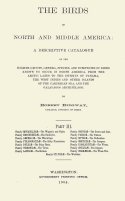

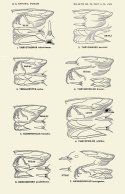 |
|
The Birds Of North And Middle America: A Descriptive Catalogue
Part II: Family Tanagridae - The Tanagers, Family Icteridae - The Troupials, Family Coerebidae - The Honey Creepers, Family Mniotiltidae - The Wood Warblers
Robert Ridgway
Bulletin No. 50
Smithsonian Institution
United States National Museum
1902
Preface: "The present volume is the second of a series which will probably require eight volumes for completion. It contains the following families: Tanagridae (Tanagers), Icteridae (Troupials), Coerebidae (Honey Creepers), and Mniotiltidae (Wood Warblers). Part I, issued in 1901, included the Family Fringillidae (Finches) alone. Part III, which is well under way, will include the Motacillidae (Wagtails and Pipits), Hirundinidae (Swallows), Vireonidae (Vireos), Ampelidae (Waxwings), Ptiliogonatidae (Silken Chatterers), Dulidae (Palm Chatterers), Laniidae (Shrikes), Corvidae (Crows and Jays), Paridae (Titmice), Sittidae (Nuthatches), Certhiidae (Creepers), Troglodytidae (Wrens), Cinclidae (Dippers), Chamaeiidae (Wren-tits), and Sylviidae (Kinglets, etc.), and will probably go to press some time during the present year. The remaining volumes are all in a more or less advanced stage of preparation and it is hoped that these may follow at the rate of two a year. Acknowledgments for the loan of material for use in the preparation of the present volume are due to the persons and public institutions mentioned in Part I (pages xii, xiii), and also to Dr. A. K. Fisher, Mr. William Palmer, and Mr. Paul Bartsch, of Washington, District of Columbia. Both Dr. Fisher and Mr. Palmer should have been mentioned in Part I in this connection, and the inadvertent omission of their names is much regretted. Most of the measurements of specimens for the present volume were made by Mr. J. H. Riley, Mr. Sidney S. Wilson, and Miss Frances E. Swett."
|
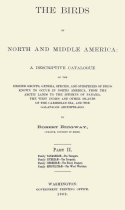
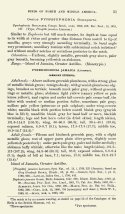
 |
|
The Birds Of North And Middle America: A Descriptive Catalogue
Part I: Family Fringillidae - The Finches
Robert Ridgway
Bulletin No. 50
Smithsonian Institution
United States National Museum
1900
From the preface: "Although preparations for the present work have been more or less actively conducted for some twenty years past, as time and opportunity permitted, the actual work of putting together the vast amount of material accumulated during that period was not begun until September, 1894, when the author was directed by Dr. G. Brown Goode, Assistant Secretary of the Smithsonian Institution, in charge of the National Museum, to consider of paramount importance among his official duties the task of 'making available, through publication, the results of the ornithological work of the Government, as represented in the collections of the Smithsonian Institution.' The labor of collating references pertaining to more than 3,000 species of birds, verifying citations of original descriptions, measuring many thousands of specimens, and other time-consuming details connected with the preparation of such a work has necessarily delayed the beginning of its publication; but most of this drudgery having been disposed of, it is hoped that future progress may be more rapid. In the following pages the attempt is made to describe every species and subspecies, or definable form, of bird found on the continent of North America, from the arctic districts to the eastern end of the. Isthmus of Panama, together with those of the West Indies and other islands of the Caribbean Sea (except Trinidad and Tobago), and the Galapagos Archipelago; introduced and naturalized species being included, as well as accidental or casual visitors. The classification presented is essentially that of the most recent and advanced authorities, with such minor modifications as in the judgment of the present author seem desirable. The imperfection of our knowledge concerning the internal structure of many groups of birds, however, makes an entirely satisfactory classification impossible at the present time, and that here adopted must therefore be considered as provisional only. An entirely sound classification of birds is a matter of the future, requiring vastly extended investigations in the field of avian anatomy and the expenditure of an enormous amount of time and labor in elaborating the results."
|
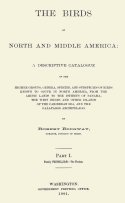
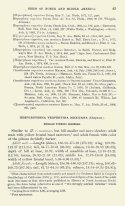
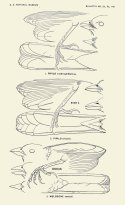 |
|
The Ornithology Of Illinois
Part I: Descriptive Catalogue by Robert Ridgway
(Volume 2: Part I)
State Laboratory For Natural History
1895
(Uncertain if this is a new edition or a reprint of material from the 1889 publication.)
|


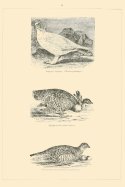 |
|
The Hawks And Owls Of The United States In Their Relation To AgricultureA.K. Fisher
Color plates: J.L. Ridgway, R. Ridgway
Division Of Ornithology And Mammology Bulletin No. 3
US Department of Agriculture
Government Printing Office
1893
From the prefatory letter: The statements herein contained respecting the food of the various hawks and owls are based on the critical examination, by scientific experts, of the actual contents of about 2,700 stomachs of these birds, and consequently may be fairly regarded as a truthful showing of the normal food of each species. The result proves that a class of birds commonly looked upon as enemies to the farmer, and indiscriminately destroyed whenever occasion offers, really rank among his best friends, and with few exceptions should be preserved, and encouraged to take up their abode in the neighborhood of his home. Only six of the 73 species and subspecies of hawks and owls of the United States are injurious. Of these, three are so extremely rare they need hardly be considered, and another (the Fish Hawk) is only indirectly injurious, leaving but two (the Sharp-shinned and Cooper's Hawks) that really need be taken into account as enemies to agriculture. Omitting the six species that feed largely on poultry and game, 2,212 stomachs were examined, of which 56 per cent contained mice and other small mammals, 27 per cent insects, and only 3 per cent poultry or game birds. In view of these facts the folly of offering bounties for the destruction of hawks and owls, as has been done by several States, becomes apparent, and the importance of an accurate knowledge of the economic status of our common birds and mammals is overwhelmingly demonstrated.
|
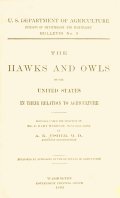


|
|
The Humming BirdsRobert Ridgway
Smithsonian Institution
United States National Museum
1892
From the introduction: Of all the numerous groups into which the birds are divided there is none other so numerous in species, so varied in form, so brilliant in plumage, and so different from all others in their mode of life. Inhabitants exclusively of the tropical and temperate portions of America, they constitute the most charming element, in the wonderfully varied bird-life of the New World. Buffon considers the Humming Bird "of all animated beings . . . the most elegant in form and brilliant in color. The stones and metals polished by art are not comparable to this gem of nature. She has placed it in the order of birds, but among the tiniest of the race maxime miranda in minimus; she has loaded it with all the gifts of which she has only given other birds a share. Agility, rapidity, nimbleness, grace, and rich attire all belong to this little favorite. The emerald, the ruby, and the topaz glitter in its garb, which is never soiled with the dust of earth, for, leading an aerial life, it rarely touches the turf even for an instant. Always in the air, flying from flower to flower, it shares their freshness and their splendor, lives on their nectar, and only inhabits those climates in which they are unceasingly renewed." Audubon calls the Humming Bird a "glittering fragment of the rainbow," and asks "Who, on seeing this lovely little creature moving on humming winglets through the air, suspended as if by magic in it, flitting from one flower to another, with motions as graceful as they are light and airy, pursuing its course and yielding new delights wherever it is seen . . . would not pause, admire, and turn his mind with reverence toward the Almighty Creator, the wonders of whose hand we at every step discover, and of whose sublime conception we everywhere observe the manifestations in his admirable system of creation." Buffon's characterization, however, is somewhat inaccurate and slightly overdrawn, since nature has not endowed Humming Birds "with all the gifts of which she has only given other birds a share," the absence of melodious voice being, as a rule, a conspicuous deficiency of the tribe, while the statement that they are "always in the air" is very inaccurate, Humming Birds requiring the same repose which other kinds find necessary.
|
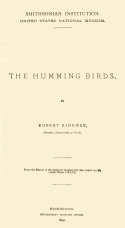
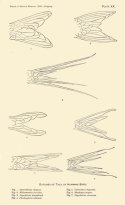
 |
|
The Ornithology Of Illinois
Part I: Descriptive Catalogue by Robert Ridgway
Part II: Economic Ornithology by S.A. Forbes
Frontispiece: Robert Ridgway
State Laboratory For Natural History
1889
(Note that though listed on the title page Part II of this work may not have been published.)
From the main section: "In the following catalogue are included only those species which undoubtedly occur at the present time, and those of whose former occurrence there exists reliable evidence. In strict accuracy, Campephilus principalis, Conurus carolincnsis, and Ajaja ajaja might with propriety be excluded from the regular list and included in a special category. I have decided to retain them, however, for the reason that any doubt which may now exist concerning their present or very recent occurrence can be supported by merely negative evidence, based upon extremely meager data; while my experience relating to other southern species, resulting from a personal, though by no means thorough, exploration of localities more than 100 miles north of Cairo, leads me to expect interesting discoveries (some of them perhaps unanticipated), from careful observations in some of the more secluded portions of the extreme southern counties of the State. It is not at all impossible that in these fastnesses, the above mentioned species may still exist. The classification and nomenclature followed in the present work are those adopted by the special committee of the American Ornithologists' Union, and used in the official check-list of the Union, now being printed. As to the classification, however, I have reversed the sequence of families and higher groups, preferring to commence, as has been customary, with the Thrushes ."
|
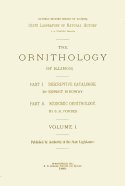
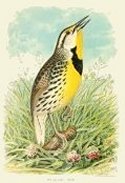
 |
|
A Manual Of North American Birds
Robert Ridgway
J.B. Lippincott Company
1887
Preface: "THE object of the present volume is to furnish a convenient manual of North American Ornithology, reduced to the smallest compass, by the omission of everything that is not absolutely necessary for determining the character of any given specimen, and including, besides the correct nomenclature of each species, a statement of its natural habitat, and other concomitant data.
Originally projected by Professor Spencer F. Baird, and based essentially upon the grand National cabinet of American birds which his energy, ability, and enthusiasm have developed from an unpretentious nucleus into a collection unrivalled in extent and wholly unique in scientific value, this work may be considered as, in a measure, the consummation of a plan conceived by that illustrious naturalist, whose works represent the highest type of systematic ornithology, and have furnished the model from which the younger generation of ornithologists have drawn their inspiration. Professor Baird's great responsibilities and engrossing duties as Secretary of the Smithsonian Institution and Director of the United States National Museum precluded the possibility of his completing the work which he had so long cherished, and had even begun, when called to the high positions which he has filled with so much advantage to science and honor to himself. Honored with the privilege of continuing the work commenced by abler hands, the author has endeavored to fulfil his trust with careful attention to the hope of its originator that the Manual of North American Birds may serve as a handy book for the sportsman and traveller, as well as for the resident naturalist, and that all may find it a convenient and satisfactory means of identifying any North American bird in all its variations of plumage."
|


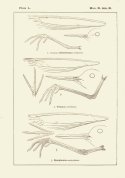 |
|
A Nomenclature Of Colors For NaturalistsAnd Compendium Of Useful Knowledge For Ornithologists
Robert Ridgway
Little, Brown and Company
1886
From the introduction: "THE present volume is intended to supply a want much felt by the author during the course of his ornithological studies, and therefore presumably experienced by other workers in the same field; namely, a nomenclature of colors and a compendious dictionary of technical terms used in descriptive ornithology, together with a series of plates or diagrams illustrating the external anatomy of a bird in relation to the terms employed, and such other things as are more clearly expressed by a picture than by a mere definition. Probably few, if any, naturalists have not on more than one occasion deplored the absence of such an aid to their studies; for it is very difficult, if not impossible, for any one to keep all these things clearly in mind.Undoubtedly one of the chief desiderata of naturalists, both professional and amateur, is a means of identifying the various shades of colors named in descriptions, and of being able to determine exactly what name to apply to a particular tint which it is desired to designate in an original description. No modern work of this character, it appears, is extant, — the latest publication of the kind which the author has been able to consult being Syme's edition of Werner's Nomenclature of Colors, published in Edinburgh in 1821, a copy of which the writer has been able to procure through the kind attentions of a correspondent in England."
|
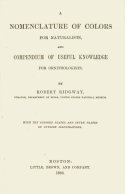
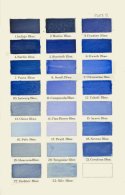
 |
|
The Water Birds Of North America, Volume I
S.F. Baird, T.M. Brewer and R. Ridgway
Publications Of The Geological Survey Of California
Little, Brown, and Company
1884
From the introduction: "As this work will in all probability fall into the hands of those who have not seen the ornithological volume issued as a part of the Publications of the State Geological Survey of California, it is proper that the origin and connection of these two contributions to this branch of American natural history should be here explained. The Act authorizing a geological survey of the State of California, which became a law in 1860, required of the State Geologist, in addition to the topographical and geological work usually expected on such a survey, ' a full and complete description of the botanical and zoological productions of California.' In accordance with this requirement, the efforts of the head of the Survey were, from the time of the beginning of the work, directed toward the collection of such material as would be of value for use in the preparation of Reports in the various departments of the natural history of California and the adjacent regions of the Pacific coast. The establishment of a State museum of geology and natural history was also contemplated - although not provided for - in the Act authorizing the Survey, as supplementary to the preparation of such Reports on the various branches of science as should make possible the study of geology, botany, and zoology in the schools and colleges of California and the adjacent States and Territories."
|

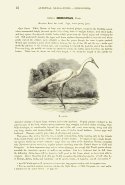
 |
|
The Water Birds Of North America, Volume II
S.F. Baird, T.M. Brewer and R. Ridgway
Publications Of The Geological Survey Of California
Little, Brown, and Company
1884
From the first description: "This genus is very readily distinguished from Querquedula by the very different form of the bill, which is more like that of Dafila, but much smaller, being much more depressed terminally, and proportionally deeper through the base than in Querquedula; while the lower edge or maxillary tomium is either gently convex throughout (as in the southern species), or straight anteriorly and decided]y convex posteriorly (as in the northern forms); the lamellae being thus completely hidden. In Querquedula, on the other hand, the terminal portion of the tomium is strongly convex, and the posterior half cut away, as it were, so as to fully expose the lamella;. Through the forms occurring in the southern hemisphere, this genus leads directly to Poecilonetta, which in turn is intermediate between Nettion and Dafila."
|
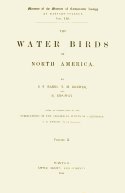
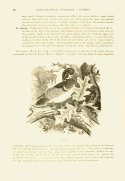
 |
|
Catalogue Of The Aquatic And Fish-Eating Birds Exhibited By The United States National Museum
R. Ridgway
Great International Fisheries Exhibition London, 1883
United States National Museum
Government Printing Office
1883
Opening lines of prefatory note: "The water birds of North America constitute almost exactly one-third of the total bird-fauna of the continent, the number of species and races known at the present time being 313, and of land birds, 642.
Much the larger proportion of the aquatic species have more or less to do with the subject of the fisheries, for the reason that they are, to a greater or less extent, destructive to fishes or are themselves extensively used for bait, the latter being conspicuously the case at the Newfoundland Banks, where several species of petrels, more especially, on account of its greater abundance, the Greater Shearwater ("Hagdon," or "Old Hag," of the fishermen, Puffinus major), constitute the principal bait in the catching of codfish."
|

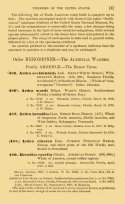 |
|
United States Geological Exploration Of The Fortieth Parallel, Report, Volume 4
Part I. Palæontology By F. B. Meek
Part II. Palæontology By James Hall and R. P. Whitfield
Part III. Ornithology By Robert Ridgway
Government Printing Office
1877
From the introduction to the ornithology section: I transmit herewith a report on the ornithology of the route explored by the United States Geological Exploration of the Fortieth Parallel, based upon field-work from June, 1867, to August, 1869, inclusive, the time during which I had the honor to serve in the capacity of zoologist to the expedition; the region investigated being that directly between Sacramento City, California, and Salt Lake City, Utah, including a few points directly to the eastward of the last-mentioned locality. The ornithological specimens preserved, and deposited in the National Museum, at Washington, number 1,522, of which 769 are skins, and 753 nests and eggs. This may seem a small collection proportioned to the time employed in its formation, but the making of protracted field-observations and the elaboration of notes therefrom were deemed of greater importance than the amassing of a large duplicate collection. Moreover, almost equal attention was given to other branches of zoology, particularly to reptiles and fishes, large series of which, representing very completely the fauna of the country, were placed, according to instructions, in the hands of specialists for identification.
|

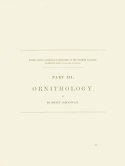
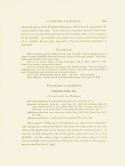 |
|
A History Of North America BirdsLand Birds, Volume I
S.F. Baird, T.M. Brewer and R. Ridgway
Little, Brown, and Company
1874
From the preface: "The present work is designed to meet the want, which has long been felt, of a descriptive account of the Birds of North America, with notices of their geographical distribution, habits, methods of nesting, character of eggs, their popular nomenclature, and other points connected with their life history.For many years past the only systematic treatises bearing upon this subject have been The American Ornithology of Alexander Wilson, finished by that author in 1814, and brought down to the date of 1827 by George Ord; the Ornithological Biography of Audubon, bearing date of 1838, with a second edition, Birds of America, embracing a little more of detail, and completed in 1844; and A Manual of the Ornithology of the United States and Canada, by Nuttall, of which a first edition was published in 1832 and a second in 1840. Since then no work relating to American Ornithology, of a biographical nature, has been presented to the public, with the exception of some of limited extent, such as those of Giraud, on the Birds of Long Island, in 1844; De Kay's Birds of New York, 1844; Samuels's Ornithology and Oology of New England, 1868, and a few others; together with quite a number of minor papers on the birds of particular localities, of greater or less moment, chiefly published in periodicals and the Proceedings of Societies."
|
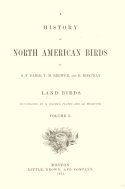
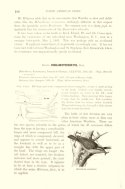
 |
|
A History Of North America BirdsLand Birds, Volume II
S.F. Baird, T.M. Brewer and R. Ridgway
Little, Brown, and Company
1874
|
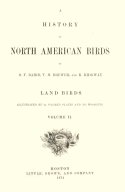

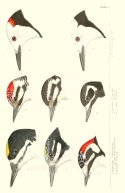 |
|
A History Of North America BirdsLand Birds, Volume III
S.F. Baird, T.M. Brewer and R. Ridgway
Little, Brown, and Company
1874
|
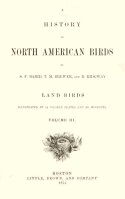

 |
|